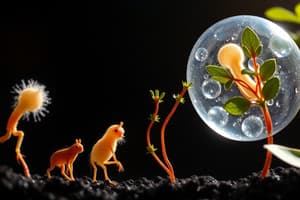Podcast
Questions and Answers
Which of the following statements accurately reflects the historical progression of understanding photosynthesis?
Which of the following statements accurately reflects the historical progression of understanding photosynthesis?
- Van Helmont correctly identified water as the sole contributor to plant mass, which was later refined by de Saussure to include carbon dioxide.
- Priestley demonstrated that plants restore 'injured air' (produce oxygen) before Senebier identified carbon dioxide's role. (correct)
- Engelman determined the effectiveness of red and blue light in photosynthesis after the discovery that oxygen comes from water.
- Sachs first identified the importance of water in photosynthesis, which was then confirmed by Van Niel and Hill to be where oxygen comes from.
If a scientist discovers a new species of algae that thrives in low-light conditions, primarily using green light for photosynthesis, which scientist's work would be MOST relevant in understanding this phenomenon?
If a scientist discovers a new species of algae that thrives in low-light conditions, primarily using green light for photosynthesis, which scientist's work would be MOST relevant in understanding this phenomenon?
- The collaborative work of Van Niel and Robin Hill on the source of oxygen.
- Jan Baptiste van Helmont, due to his early work on plant nutrition.
- The contemporary botanists studying NADP+ as a final electron acceptor.
- The work of Engelmann who used algae and a prism to understand which wavelengths were the most effective in producing oxygen. (correct)
Consider an experiment where a plant is grown in a sealed chamber with a known amount of water and carbon dioxide, under controlled light conditions. If the plant exhibits significant growth and oxygen production, which equation BEST represents the overall process occurring within the chamber?
Consider an experiment where a plant is grown in a sealed chamber with a known amount of water and carbon dioxide, under controlled light conditions. If the plant exhibits significant growth and oxygen production, which equation BEST represents the overall process occurring within the chamber?
- $H_2O \rightarrow O_2 + Electrons + H^+$
- $CO_2 + Light \rightarrow Organic Matter + O_2$
- $CO_2 + H_2O + Light \rightarrow Organic Matter + O_2$ (correct)
- $O_2 + Organic Matter \rightarrow CO_2 + H_2O + Energy$
In a hypothetical scenario, researchers isolate chloroplasts from plant cells and expose them to light in the presence of water but without carbon dioxide. Based on the work of van Niel and Hill, what would be the MOST likely outcome?
In a hypothetical scenario, researchers isolate chloroplasts from plant cells and expose them to light in the presence of water but without carbon dioxide. Based on the work of van Niel and Hill, what would be the MOST likely outcome?
During the historical investigation of photosynthesis, several scientists made key contributions. If a scientist hypothesized that a specific compound, 'Compound X,' is the immediate precursor to NADPH in photosynthesis, which previously discovered component of photosynthesis would 'Compound X' MOST likely interact with?
During the historical investigation of photosynthesis, several scientists made key contributions. If a scientist hypothesized that a specific compound, 'Compound X,' is the immediate precursor to NADPH in photosynthesis, which previously discovered component of photosynthesis would 'Compound X' MOST likely interact with?
During photosynthesis, which of the following transformations represents a reduction reaction?
During photosynthesis, which of the following transformations represents a reduction reaction?
If a plant cell is exposed to a toxin that inhibits the release of oxygen during the light-dependent reactions of photosynthesis, which of the following processes would be directly affected?
If a plant cell is exposed to a toxin that inhibits the release of oxygen during the light-dependent reactions of photosynthesis, which of the following processes would be directly affected?
How would the rate of photosynthesis be affected if a plant's stomata were unable to open and close?
How would the rate of photosynthesis be affected if a plant's stomata were unable to open and close?
Which of the following best describes the relationship between the light-dependent and light-independent reactions of photosynthesis?
Which of the following best describes the relationship between the light-dependent and light-independent reactions of photosynthesis?
If a plant is exposed to only green light, what would be the most likely effect on its photosynthetic activity?
If a plant is exposed to only green light, what would be the most likely effect on its photosynthetic activity?
Considering the complete equation for photosynthesis ($6CO_2 + 12H_2O + light \ energy
ightarrow C_6H_{12}O_6 + 6O_2 + 6H_2O$), where do the atoms in the glucose molecule ($C_6H_{12}O_6$) ultimately originate?
Considering the complete equation for photosynthesis ($6CO_2 + 12H_2O + light \ energy ightarrow C_6H_{12}O_6 + 6O_2 + 6H_2O$), where do the atoms in the glucose molecule ($C_6H_{12}O_6$) ultimately originate?
Which of the following metabolic processes is most similar to the light-dependent reactions of photosynthesis in terms of energy conversion?
Which of the following metabolic processes is most similar to the light-dependent reactions of photosynthesis in terms of energy conversion?
How does the cyclic electron flow in the light-dependent reactions contribute to photosynthesis?
How does the cyclic electron flow in the light-dependent reactions contribute to photosynthesis?
Flashcards
Plants are soil eaters
Plants are soil eaters
Plants don't just eat soil; they synthesize matter, disproving Aristotle's initial theory.
Photosynthesis needs CO2
Photosynthesis needs CO2
Plants use carbon dioxide (CO2) during photosynthesis.
Two gases in Photosynthesis
Two gases in Photosynthesis
Photosynthesis involves both oxygen (O2) and carbon dioxide (CO2).
Photosynthesis Equation
Photosynthesis Equation
Signup and view all the flashcards
Final Electron Acceptor
Final Electron Acceptor
Signup and view all the flashcards
Photosynthesis
Photosynthesis
Signup and view all the flashcards
Oxidation
Oxidation
Signup and view all the flashcards
Reduction
Reduction
Signup and view all the flashcards
Reactant Fate in Photosynthesis
Reactant Fate in Photosynthesis
Signup and view all the flashcards
Photosynthesis Location
Photosynthesis Location
Signup and view all the flashcards
Stomata
Stomata
Signup and view all the flashcards
Light Reactions
Light Reactions
Signup and view all the flashcards
Photons
Photons
Signup and view all the flashcards
Study Notes
History of Photosynthesis
- Aristotle thought plants grew by consuming soil, which was later disproven.
- Jan Baptitste van Helmont's willow tree experiment, though partially correct, established groundwork for understanding plant nutrition.
- Joseph Priestley found vegetation requires injured air; plants produce oxygen, linking plant activity to atmospheric oxygen.
- Jean Senebler, a Swiss botanist, showed photosynthesis depends on carbon dioxide (fixed air), clearly connecting plants and carbon dioxide.
- Antoine Lavoisier identified oxygen and carbon dioxide as the two gases in photosynthesis.
- Nicholas de Saussure expanded on earlier studies, establishing that plants absorb water and carbon dioxide, essential for organic matter production.
- The core of photosynthesis can be represented as: CO2 + H2O + Light = Organic Matter + O2.
- Engelman found red and blue light are effective in producing oxygen during photosynthesis, using filamentous algae and a prism.
- Sachs linked chlorophyll distribution to carbohydrate production areas, reinforcing chlorophyll's role as a light capturing molecule.
- Van Niel and Robin Hill determined oxygen comes from water, transforming the understanding of photosynthesis when Robin Hill's experiment confirmed it.
- NADP+ is the final electron acceptor in photosynthesis.
- Modern research shows that the final electron acceptor is NADP+, forming NADPH, crucial for driving the Calvin cycle and synthesizing sugars.
Photosynthesis
- Photosynthesis is an anabolic, endergonic, carbon dioxide-requiring process where light energy (photons) and water produce organic macromolecules (glucose).
- Water oxidizes and carbon dioxide reduces during the redox process of photosynthesis
- The photosynthesis equation is: 6CO2 + 12H2O + light energy = C6H12O6 + 6O2 + 6H2O.
- Oxidation involves adding oxygen, removing hydrogen, losing electrons, and releasing energy (exergonic).
- Reduction involves removing oxygen, adding hydrogen, gaining electrons, and storing energy (endergonic).
- The reactants in photosynthesis are 6CO2 and 12H2O.
- The products of photosynthesis are C6H12O6, 6H2O, and 6O2.
Where Photosynthesis Takes Place
- Photosynthesis occurs in all photoautotrophic organisms.
- Examples of photoautotrophic organisms include mosses, ferns, flowering plants, kelp, euglena, and cyanobacteria.
- True plants' leaves are the major sites of photosynthesis, but all organs with photosynthetic pigments can perform photosynthesis.
- Stomata allow plants to absorb carbon dioxide and release oxygen.
The Sites of Photosynthesis
- There are two processes: light processes and dark processes.
- Light processes are light-dependent, photochemical processes that produce oxygen
- Dark processes are light-independent or carbon fixation processes that produce glucose
- Solar energy converts to chemical energy (ATP and NADPH) during light reactions.
Light Reactions
- Light consists of photons, each carrying a fixed quantity of energy.
- Light travels in waves and is a form of electromagnetic energy
- Wavelength determines the electromagnetic energy.
- All electromagnetic energy, or radiation, is called the electromagnetic spectrum.
- Plants can absorb light in the UV to infrared spectrum, which includes all visible light.
- Sunlight has a mixture of many wavelengths.
- During the light reaction, water enters and produces oxygen, ATP, and NADPH when light hits the Thylacoid or the granium of the chlorophyll.
- The Calvin cycle requires ATP and NADPH.
The Visible Light Spectrum
- The visible light spectrum includes the colors of light we can see (=reflected radiation).
- It includes the wavelengths that drive photosynthesis and is absorbed by photosynthetic pigments.
Studying That Suits You
Use AI to generate personalized quizzes and flashcards to suit your learning preferences.




